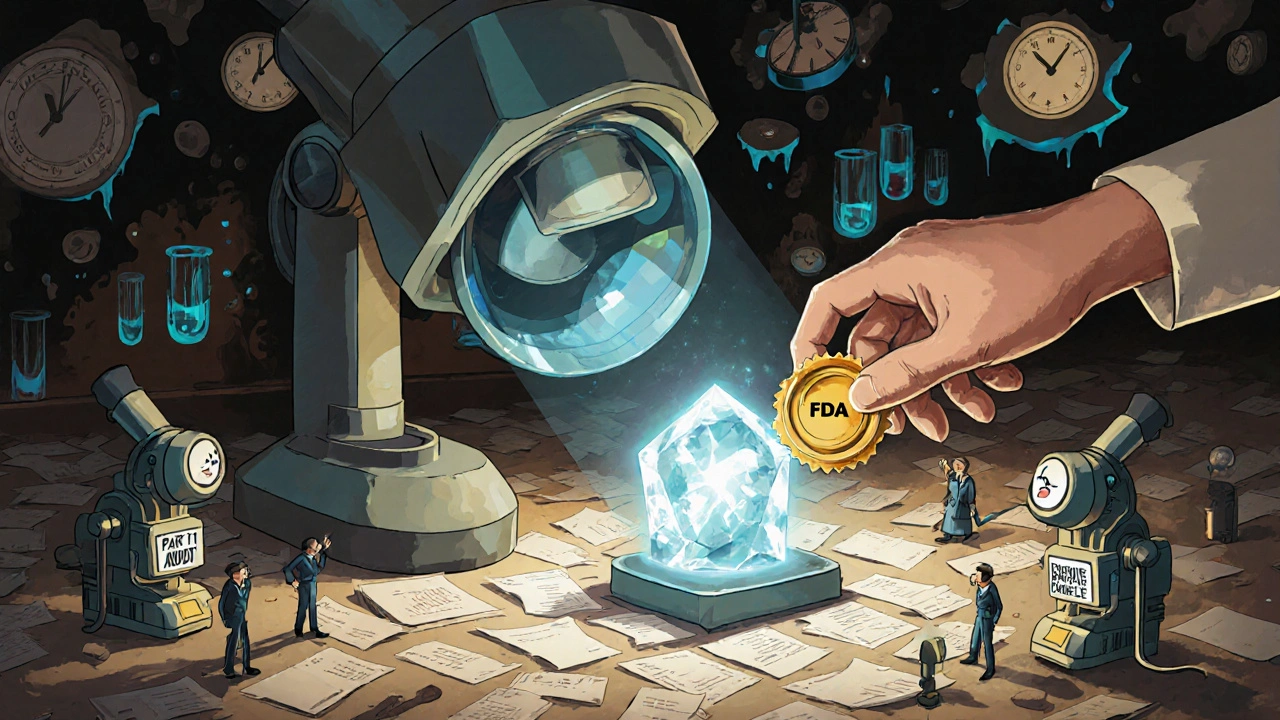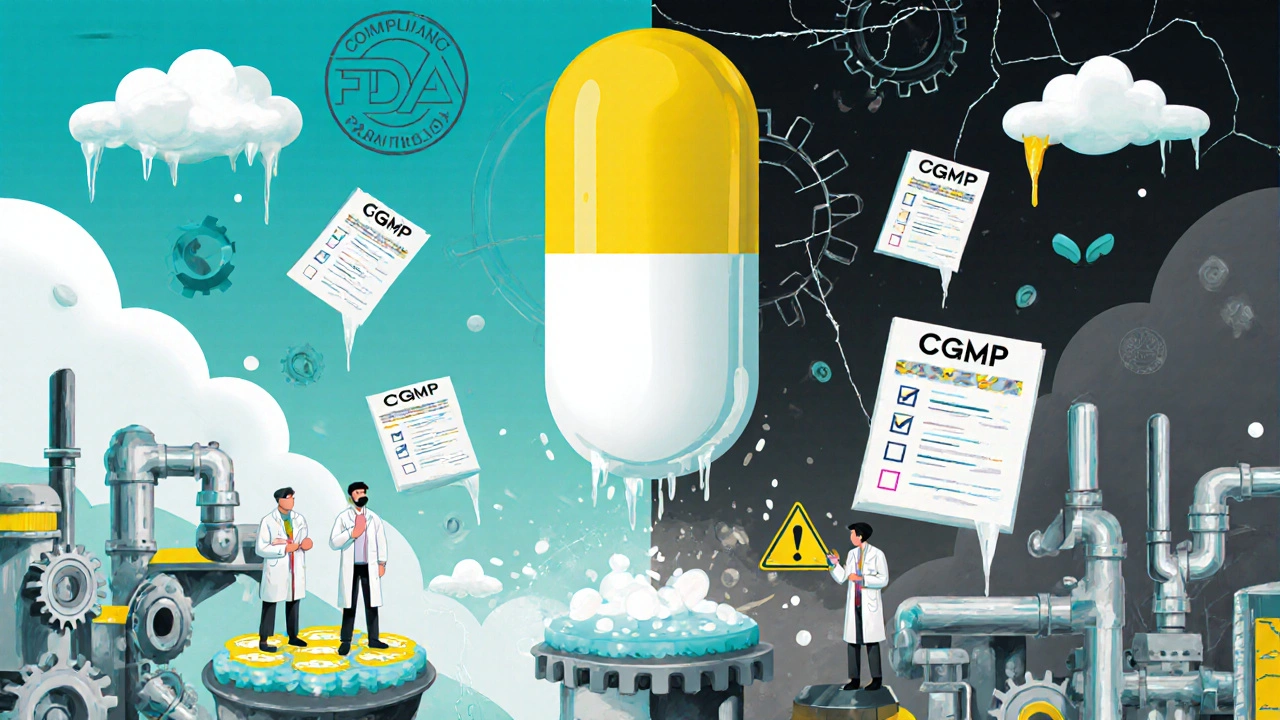When you pick up a generic pill at the pharmacy, you expect it to work just like the brand-name version. That’s not luck. It’s because the FDA enforces strict rules called Current Good Manufacturing Practices (CGMP) to make sure every generic drug is safe, pure, and effective. These aren’t suggestions. They’re legal requirements. And they apply to every generic drug made in the U.S. or imported here - no exceptions.
What Exactly Are CGMPs for Generic Drugs?
CGMP stands for Current Good Manufacturing Practices. It’s the set of rules the FDA uses to ensure that drugs are made consistently and meet quality standards. For generics, these rules are identical to those for brand-name drugs. There’s no lower bar. The FDA doesn’t treat generics as second-class products. They must be manufactured under the same conditions, with the same controls, and using the same level of oversight.
The legal foundation comes from Section 501(a)(2)(B) of the Federal Food, Drug, and Cosmetic Act. The rules themselves are written in 21 CFR Parts 210 and 211. These regulations were first codified in 1978, but they’ve been updated constantly since then - especially as technology and risks evolve. The word “current” is critical. It means manufacturers can’t rely on old methods. They must use modern tools, up-to-date equipment, and validated processes. If a company is still using paper logs and manual checks in 2025, they’re already out of compliance.
The Core Requirements: What Manufacturers Must Do
CGMP isn’t a single rule. It’s a system made up of 11 detailed subparts under 21 CFR Part 211. Here’s what it actually looks like on the ground:
- People: Every employee who touches the drug must be trained and qualified. Training records are mandatory. No one works on a batch without documented proof they know how.
- Facilities: Cleanrooms, air filters, humidity controls - everything is regulated. Air quality standards are specific. Dust, microbes, and cross-contamination are not allowed.
- Equipment: Every machine must be cleaned, calibrated, and maintained on a schedule. Records of every maintenance check must be kept for at least one year after the product expires.
- Components: Every batch of active ingredient (API) and excipient must be tested before use. No guessing. No assumptions. If a supplier sends you a batch, you test it yourself.
- Production: Every step of making the drug - mixing, granulating, compressing, coating - must be validated. That means proving the process consistently produces the same result, batch after batch. Most companies use three consecutive batches to validate a process, even though the FDA doesn’t require a minimum number.
- Labeling: Labels must be verified before they go on the bottle. A wrong label on a generic drug is a serious violation. It can lead to recalls or worse.
- Testing: Every batch must be tested for strength, purity, and identity. Stability testing must be done over time to prove the drug won’t break down before its expiration date.
- Records: Everything is documented. From who did what, to when, to what machine was used. Electronic records must follow 21 CFR Part 11 - meaning they have secure audit trails, user authentication, and cannot be altered.
These aren’t vague guidelines. They’re precise. For example, equipment cleaning validation requires swab and rinse samples. Acceptance limits are set at no more than 100 CFU (colony-forming units) per swab. That’s a measurable, testable standard - not a suggestion.
Why This Matters for Patients
The U.S. generic drug market is worth over $105 billion. Ninety percent of all prescriptions filled are for generics. That’s not because they’re cheaper - though they are. It’s because patients and doctors trust them. That trust comes from CGMP.
Without these rules, you’d have no way to know if the generic you bought was made in a dirty facility, with untested ingredients, or under inconsistent conditions. You’d be gambling with your health. CGMP ensures that the generic metformin you take for diabetes has the same active ingredient, in the same amount, and breaks down in your body the same way as the brand-name version. The FDA doesn’t just approve the formula - they approve the entire manufacturing system.
When things go wrong, it’s usually because CGMP was ignored. In 2022, 12 generic metformin products were recalled because of NDMA contamination. The FDA’s warning letters blamed “inadequate process controls and failure to validate cleaning procedures.” That’s a direct CGMP violation. People didn’t get sick because the drug was bad - they got sick because the system failed.

How CGMP Compares to Global Standards
The FDA’s CGMP is not the only standard in the world. The European Medicines Agency (EMA) has its own GMP guidelines. According to a 2021 ICH assessment, they’re about 85% aligned. But the differences matter.
The FDA requires a dedicated Quality Unit with real authority - not just a department that reports to production. This unit can shut down a line, reject a batch, or halt shipments. In some other regions, that authority is weaker. The FDA also requires more detailed documentation. A 2021 Avalere Health study found CGMP compliance costs 18% more in the U.S. than in some other markets - mostly because of recordkeeping.
Another big difference: inspection frequency. Domestic U.S. facilities get inspected about 1.3 times per year on average. Foreign facilities? Less. In 2020-2022, foreign plants received 43% fewer warning letters per inspection than U.S. ones. That’s a point of serious criticism from experts like Harvard’s Aaron Kesselheim. The FDA says it’s fixing this - their 2023-2027 plan allocates 25% more resources to foreign inspections.
Real Challenges in the Industry
Complying with CGMP isn’t easy. For small generic manufacturers, it’s a huge burden. A 2022 ISPE survey found 68% of companies struggle with documentation. One company on Reddit said switching to electronic batch records cost $1.2 million and took 14 months.
Common pain points:
- Implementing Part 11 for electronic records - 78% of firms report trouble with audit trails
- Testing active pharmaceutical ingredients (APIs) - 43% of manufacturers had component failures in 2022
- Inconsistent FDA inspections - 57% of manufacturers say inspectors interpret rules differently
But there are success stories. Teva Pharmaceutical implemented continuous manufacturing for a generic heart drug. Instead of making batches in large chunks, they made it continuously - like a流水线. Result? Batch failures dropped from 4.2% to 0.7%. And it was fully CGMP-compliant.

What’s Changing in 2025 and Beyond
CGMP isn’t frozen in time. The FDA is pushing for modernization. In May 2023, they issued an immediate guidance requiring testing for toxic contaminants like diethylene glycol and ethylene glycol in high-risk ingredients - a direct response to deaths linked to contaminated generics in Pakistan.
Next up: continuous manufacturing. The FDA’s Emerging Technology Program is working on new guidance expected in mid-2024. This will help manufacturers move away from old batch-based validation toward real-time quality control.
AI and predictive analytics are coming. By 2028, McKinsey predicts 65% of manufacturers will use AI to predict quality issues before they happen. That’s the future - not just testing after the fact, but preventing problems before they occur.
Supply chain security is another focus. The Drug Supply Chain Security Act is being rolled out. Expect stricter checks on API suppliers, especially from countries with a history of violations.
How to Get Started
If you’re starting a generic drug manufacturing operation, here’s what you need:
- Build a Quality Management System (QMS) with written procedures for every step.
- Qualify your facility - Installation Qualification (IQ), Operational Qualification (OQ), Performance Qualification (PQ).
- Validate your processes - at least three consecutive batches for critical steps.
- Train every employee - 80-120 hours of CGMP training per year is standard.
- Invest in electronic systems - paper records are a liability.
The whole process from building a facility to making your first commercial batch takes 18-24 months. It’s expensive. But it’s the only way to sell in the U.S. market.
Final Reality Check
There’s no shortcut. No loophole. No “good enough.” If your CGMP system fails, the FDA can shut you down. They can seize your product. They can block your imports. They can fine you millions.
CGMP for generics isn’t about being perfect. It’s about being consistent. It’s about knowing that every pill, every capsule, every tablet - whether made in New Jersey or New Delhi - meets the same standard. That’s what keeps patients safe. That’s why the system exists.
And as long as generics make up 90% of prescriptions, that standard won’t change. It will only get stronger.
Are generic drugs held to the same manufacturing standards as brand-name drugs?
Yes. The FDA requires that generic drugs be manufactured under the exact same Current Good Manufacturing Practices (CGMP) as brand-name drugs. There is no separate or lower standard. The active ingredient, dosage, strength, and manufacturing controls must be identical. The only difference is the name and price.
What happens if a generic drug manufacturer violates CGMP?
Violations can lead to FDA warning letters, product recalls, import bans, or even criminal charges. In 2022, 12 generic metformin products were recalled due to NDMA contamination, which the FDA linked to failed cleaning and process controls. Facilities can be shut down until they fix the issues. Foreign manufacturers can be barred from importing into the U.S. entirely.
Do FDA inspections differ between U.S. and foreign manufacturing sites?
Yes. Domestic facilities are inspected more frequently - about 1.3 times per year on average. Foreign facilities historically received fewer inspections and fewer warning letters per inspection. However, the FDA’s 2023-2027 strategic plan now allocates 25% more resources to foreign inspections to close this gap. Data from 2020-2022 showed foreign sites received 43% fewer warning letters per inspection than U.S. sites.
How much does CGMP compliance cost generic manufacturers?
Compliance costs vary by company size. Mid-sized generic manufacturers spend an average of $2.3 million annually on CGMP compliance. For small firms, this can be 12-15% of total manufacturing costs. Major expenses include documentation systems, validation, training, and electronic recordkeeping (Part 11). A single facility switching to electronic batch records reported spending $1.2 million over 14 months.
What are the most common CGMP violations?
In 2022, the FDA cited laboratory controls and production process controls as the top two sources of violations, making up 41% of all CGMP issues. Data integrity problems - especially in foreign facilities - were also widespread. Common failures included missing audit trails, unvalidated equipment, inadequate cleaning procedures, and failure to test components before use.
Is continuous manufacturing allowed under CGMP?
Yes. Continuous manufacturing is fully allowed under CGMP and is actively encouraged by the FDA. Teva Pharmaceutical successfully implemented it for a generic cardiovascular drug in 2021, reducing batch failures from 4.2% to 0.7%. The FDA’s Emerging Technology Program is developing new guidance to help more manufacturers adopt this approach, with draft rules expected in 2024.
What’s new in FDA’s 2023 CGMP guidance?
In May 2023, the FDA issued an immediately effective guidance requiring manufacturers to test high-risk ingredients - like glycerin and sorbitol - for toxic contaminants such as diethylene glycol and ethylene glycol. This was a direct response to deaths linked to contaminated generic drugs in Pakistan. It’s now mandatory for all suppliers of these components.
Can a generic drug be approved without CGMP compliance?
No. CGMP compliance is mandatory for every Abbreviated New Drug Application (ANDA). The FDA reviews manufacturing facilities before approving any generic drug. If the facility is not in compliance, the application is denied - regardless of how good the drug’s chemistry is. There is no exception.


Liam Strachan
Really appreciate this breakdown. I’ve always wondered how generics could be so cheap and still work. Turns out it’s not magic-it’s just really strict rules keeping things on the level.
Johannah Lavin
This is the kind of post that makes me trust my meds again. So many people think generics are 'fake' or 'watered down'-but nope. The system’s actually designed to protect us, even if it’s boring as hell to read about.
Also big ups to Teva for going continuous. That’s the future.
Destiny Annamaria
Just got my generic lisinopril refill. No idea what CGMP is, but now I do. And honestly? Kinda cool that someone’s checking every single pill. 🙌
Matthew Karrs
Let’s be real-this is all theater. The FDA doesn’t inspect 90% of foreign plants properly. You think they’re checking swab samples in some basement lab in India? Nah. They’re just rubber-stamping paperwork while the real stuff gets shipped in.
Remember the heparin scandal? The metformin NDMA mess? All because someone didn’t feel like validating a cleaning protocol. This system works on paper. In practice? It’s a joke.
And don’t even get me started on Part 11. Companies pay millions to fake audit trails. The software’s just a glorified Word doc with a lock icon.
Don’t believe the hype. The FDA’s underfunded, overstretched, and too cozy with big pharma. You think they’re going to shut down a plant that makes 80% of the world’s metformin? Please. They’ll issue a warning letter and call it a day.
Meanwhile, your generic blood pressure med? Could be made in a shed with a 1998 tablet press. And you’ll never know.
And yes, I’ve read the 2023 plan. 25% more foreign inspections? That’s like adding one cop to patrol all of Texas.
Stay skeptical. Always.
daniel lopez
Exactly. And who’s paying for all this 'compliance'? YOU. Every extra dollar spent on paper trails and audit trails gets tacked onto your co-pay. The FDA doesn’t care about patients-they care about liability. They’d rather shut down a small plant than admit the system is broken.
And don’t tell me about Teva’s 'success.' That’s a billion-dollar company. What about the mom-and-pop generics makers? They’re getting crushed. The system isn’t about safety-it’s about control.
They want you to think it’s all clean and regulated. It’s not. It’s corporate theater with a side of bureaucracy.
Next time you take a pill, ask yourself: who really benefits here?
Michael Fessler
Just a quick note-when they say 'validation requires three consecutive batches,' that’s a de facto standard, not a regulatory mandate. The FDA doesn’t specify a number, but industry consensus says three because anything less is statistically unreliable. Also, Part 11 compliance isn’t about 'faking' audit trails-it’s about cryptographic hashing and user authentication. Most failures come from poor implementation, not corruption.
And yes, foreign inspections are a problem. But the FDA’s been ramping up remote assessments using data analytics. It’s not perfect, but it’s evolving.
Also, 43% of component failures in 2022? That’s actually a 12% drop from 2020. Progress, even if slow.
Nosipho Mbambo
Okay, but... why does it cost $2.3 million per year? That’s insane. And why are we letting foreign countries make 90% of our meds? This isn’t 'safety'-it’s global supply chain dependency wrapped in regulatory jargon. We’re literally trusting our health to factories we can’t even visit.
Also, 'audit trails'? That’s just fancy logging. Anyone with admin access can still delete logs. I’ve seen it.
And why do we even need 'continuous manufacturing'? Isn’t batch production fine? It’s worked for 50 years. Why fix what isn’t broken?
King Over
My grandma takes six generics a day. She doesn’t know what CGMP is. She just knows they work. Maybe that’s all that matters.
Ron and Gill Day
Wow. So much text. Let me summarize: the FDA is a useless bureaucracy that overcharges companies and scares small manufacturers into oblivion. Meanwhile, the real problem is that we outsource everything to China and India and then pretend we’re safe. Wake up.
Gerald Cheruiyot
There’s something beautiful about this system. It’s not glamorous. No one cheers when a batch passes stability testing. No one posts about it on TikTok.
But every time you swallow a pill and it works exactly as it should-that’s the result of thousands of hours of calibration, documentation, training, and quiet discipline.
We don’t celebrate it because it’s invisible. But it’s the foundation of modern medicine.
And yes, it’s flawed. But it’s the best flawed system we’ve got.
Maybe the real question isn’t whether CGMP works.
It’s whether we’re willing to pay for it.
Because if we stop paying-literally and figuratively-the whole thing unravels.
Katie Magnus
Ugh. So you’re telling me the government is actually doing something right? That’s just... too much. I need to go lie down.